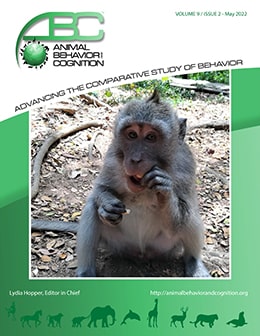Vol 9, Issue 2, May 2022
Two Types of Withdraw-to-Eat Movement Related to Food Size in Long-Tailed Macaques (Macaca fascicularis): Insights into the Evolution of the Visual Control of Hand Shaping in Anthropoid Primates
Citation
Hirsche, L. A., Cenni, C., Leca, J-B., & Whishaw, I. Q. (2022). Two types of withdraw-to-eat movement related to food size in long-tailed macaques (Macaca fascicularis): Insights into the evolution of the visual control of hand shaping in anthropoid primates. Animal Behavior and Cognition, 9(2), 176-195. https://doi.org/10.26451/abc.09.02.02.2022
Abstract
The details of the evolutionary steps in the transition from nonvisual guidance of hand movements for feeding, as displayed by many non-primate species, to visual guidance of hand movements in primates are sparse. Contemporary theory holds that a small-bodied stem primate evolved visual control of the reach to guide a hand to obtain small insects and fruit items from the terminal branches of trees. The subsequent evolution of the visual control of hand and finger shaping movements of the grasp of anthropoids is uncertain. The present study finds that Balinese long-tailed macaques (Macaca fascicularis), video recorded while spontaneously eating at the Sacred Monkey Forest Sanctuary in Ubud in Indonesia, displayed two types of hand movements associated with two types of withdraw movements to place food items in the mouth. Small food items were brought directly to the mouth with hand supination, often with no visual monitoring after grasping. Large food items that protruded from the hand were visually monitored to orient the food item on the initial part of the withdraw but visually disengaged with a head movement and often a blink before the item was placed in the mouth. The results are discussed in relation to the idea that visual information related to orientating food items of varying sizes to an appropriate position in the mouth contributed to the evolution of the visual control of hand shaping skills in anthropoid primates.
